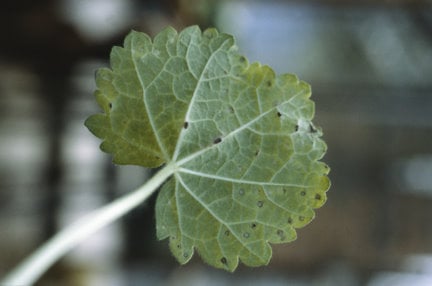
Quick facts
Common name - Hollyhock rust
Scientific name - Puccinia malvacearum
Plants affected - Hollyhock (Althaea rosea) and Malva spp. Also Abutilon, Hibiscus, Lavatera, Malvastrum and Sidalcea
Main symptoms - Yellow or orange spots on upper leaf surface, reddish-brown pustules on lower
Caused by - Fungus
Timing - Summer, particularly if wet
What is hollyhock rust?
Hollyhock rust is a fungal disease of the aerial parts of the plant, caused by Puccinia malvacearum. It is spread by airborne spores. The disease will invariably develop on untreated hollyhocks, although it is worse during wet summer weather.
Leaves, stems and calyces (outer parts of the flower) can all be attacked. Heavy attacks stunt plants and reduce their vigour.
Symptoms
You may see the following symptoms:
- Bright yellow or orange spots on the upper leaf surface
- Reddish-orange to brown, lumpy, spore-producing pustules on the corresponding lower surface
- The pustules turn ash-grey under conditions of high , as airborne spores are produced
- The disease tends to start on lower leaves and spreads up the plant
- Severely affected leaves shrivel and fall, and plants are stunted and lacking in vigour
- Pustules are also produced on the stems and calyx, and occasionally on the upper leaf surface

Control
The RHS believes that avoiding pests, diseases and weeds by good practice in cultivation methods, selection, and encouraging or introducing natural enemies, should be the first line of control. If chemical controls are used, they should be used only in a minimal and highly targeted manner.
Control of hollyhock rust is not easy, even when fungicides are used. Spores of the fungus can travel long distances, so will arrive continually from surrounding gardens and wild plants.
Non-chemical control
- Check plants regularly and remove and dispose of affected leaves
- Dispose of heavily infected plants
- Do not use seed from affected plants
- Monitor bought-in plants closely for development of symptoms
- Hollyhocks will live for several years, but to reduce the threat from rust consider growing them as a , discarded after flowering
- Alternatively, as even heavily-infected plants will often still produce at least some flowers, you could grow somewhat shorter plants in front of hollyhocks to hide the leaf symptoms but not the flower spikes
- If keeping plants for more than one flowering season, cut them right down to soil level in autumn, dispose of all leaf debris from around them, and be vigilant for the first rust symptoms in spring
- Avoid dense planting as this will lead to high around the foliage
- Encourage good root development by avoiding over-wet or over-dry soil conditions
- Control common mallow and avoid growing other plants in the Malvaceae family (e.g. Abutilon, Hibiscus, Lavatera, Malva, Malvastrum and Sidalcea) if hollyhocks are an important feature of the garden
Fungicides
The RHS recommends that you don't use fungicides. Fungicides (including organic types) may reduce , impact soil health and have wider adverse environmental effects. If you do intend to use a fungicide, please read the information given in the link and download below to ensure that use, storage and disposal of the product is done in a responsible and legally compliant manner.
The products listed in the ‘Fungicides for gardeners’ document below are legally available for use by home gardeners in the UK. This information is provided to avoid misuse of legal products and the use of unauthorised and untested products, which potentially has more serious consequences for the environment and wildlife than when products are used legally. Homemade products are not recommended as they are unregulated and usually untested.
Download
Fungicides for gardeners (Adobe Acrobat pdf document outlining fungicides available to gardeners)
Link
Biology
The rust fungi are described as biotrophs; that is, they grow within the living tissues of the plant and extract from the cells. Although they do not kill tissues rapidly, heavy attacks by rusts can cause tissues to collapse and die prematurely and this is the case with hollyhock rust.
The reddish-orange pustules on the leaf undersides contain numerous spores called teliospores that remain embedded within the leaf. Under humid conditions the teliospores germinate to produce a second spore type called a basidiospore. It is the production of the minute basidiospores that causes the pustules to turn an ash-grey colour, and it is these spores that are carried in air currents to create new infections when they land on other hollyhock leaves.
Infection is favoured by wet or humid conditions. The disease is therefore most problematic during wet summers, but it is so aggressive that plants are invariably affected even in dry years.
The fungus overwinters on the few green leaves remaining at the base of hollyhocks and mallows, and may also survive within the crown of the plant. New leaves emerging in spring soon produce rust pustules. The fungus has not been found within the embryo of hollyhock seeds, but the seed could still carry infection in the form of spores on accompanying bracts or flower parts.
Like many rust diseases, hollyhock rust has a ‘latent period’, when infection of the plant has occurred but symptoms are not yet visible. Depending on environmental conditions this latent period can range from a few days to several weeks. It is therefore possible that bought-in plants could be harbouring the disease. Plants grown on nurseries are often treated with fungicides, which may suppress the fungus without killing it.
Susceptibility: In addition to hollyhocks, the rust can also affect a number of other plants in the Malvaceae family, including Abutilon, Hibiscus, Lavatera, Malvastrum and Sidalcea. It affects common mallow (Malva sylvestris), a perennial found frequently on roadsides and waste places (particularly in England and Wales) and sometimes grown as part of a meadow.










